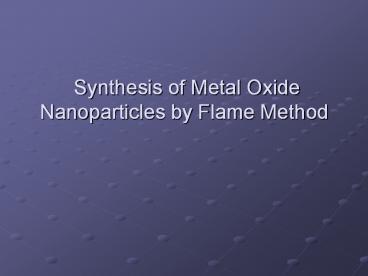Synthesis of Metal Oxide Nanoparticles by Flame Method - PowerPoint PPT Presentation
Title:
Synthesis of Metal Oxide Nanoparticles by Flame Method
Description:
Chemical methods of material processing were known for years, existing in ... on the anode by means of electrolysis of respective metal salts has been known ... – PowerPoint PPT presentation
Number of Views:2409
Avg rating:3.0/5.0
Title: Synthesis of Metal Oxide Nanoparticles by Flame Method
1
Synthesis of Metal Oxide Nanoparticles by Flame
Method
2
(No Transcript)
3
Plasma Spray Process
Schematic Diagram of the
Plasma Spray Process
4
Wet Technologies for the Formation ofOrganic
Nanostructures
5
- Chemical methods of material processing were
known for years, existing in parallel with
physical methods of film deposition. Recent
advances in electron microscopy and scanning
nanoprobe microscopy (STM, AFM) have revealed
that some of the materials produced by the
chemical methods have distinctive nanocrystalline
structure. Furthermore, due to the achievements
of colloid chemistry in the last 20 years, a
large variety of colloid nanoparticles have
become available for film deposition. This has
stimulated great interest in further development
of chemical methods as cost-effective
alternatives to such physical methods as thermal
evaporation magnetron sputtering chemical and
physical vapor deposition (CVD, PVD) and
molecular beam epitaxy (MBE). This chapter will
review chemical methods of film deposition, with
the emphasis on novel techniques for
nanostructured materials processing.
6
Self-Assembly of Colloid Nanoparticles
- The deposition of colloid nanoparticles onto
solid substrates can be accomplished - by different methods, such as simple casting,
electrostatic deposition, Langmuir- - Blodgett, or spin coating techniques, which will
be discussed in detail later in this - course. However, the simplest method of
nanoparticles deposition, which gives - some remarkable results, is the so-called
self-assembly or chemical self-assembly - method. This method, which was first introduced
by Netzer and Sagiv 12, is based - upon strong covalent bonding of the adsorbed
objects (i.e., monomer or polymer - molecules and nanoparticles) to the substrate via
special functional groups.
7
Electrodeposition of Nanostructured Materials
- Electrodeposition is one of the first chemical
(or rather electrochemical) methods for the
formation of inorganic coatings on solid
surfaces. The formation of metal coatings on the
anode by means of electrolysis of respective
metal salts has been known since the nineteenth
century. During the last few decades, this method
has spread to other materials, such as II-VI and
II-V semiconductor materials, with the main
application in photovoltaic devices and solar
cells.
8
The first route is more traditional, and is based
on the well-developed technique of
electroplating. In order to form nanostructured
materials, some kind of surfactants should be
added to the electrolyte solution. The
surfactants act as a stabilizing agent to coat
nanocrystals and to prevent them from further
aggregation, and therefore the formation of large
grains of material. The review papers 20, 21
present a variety of materials, including metals,
semiconductors, ceramics, and polymers,deposited
in this way. A classical example of gold
nanoparticles deposition is given in 22.
Monodispersed gold nanoparticles of a few
nanometers were fabricated and deposited
simultaneously on the silicon surface by the
galvanostatic reduction of HAuCl4 in the presence
of dodecanethiol.
9
Schematic diagram of spurting machine
www.angstromsciences.com, 2002.
10
Spin Coating
- The method of spin coating was known for decades
as a main technique for the - deposition of polymer layers onto flat solid
surfaces, and particularly for photoresist - deposition in microelectronics fabrication. The
idea is very simple, and consists of - spreading of a polymer solution onto the
substrate fixed on a stage, rotating at a - speed in the order of thousands of revolutions
per minute. Under the influence of the - central force, the polymer solution spreads
evenly over the large area and dries out, - due to the solvent evaporation during the
rotation. After additional baking at elevated
temperatures, a polymer layer is finally formed
on the surface.
11
(No Transcript)































